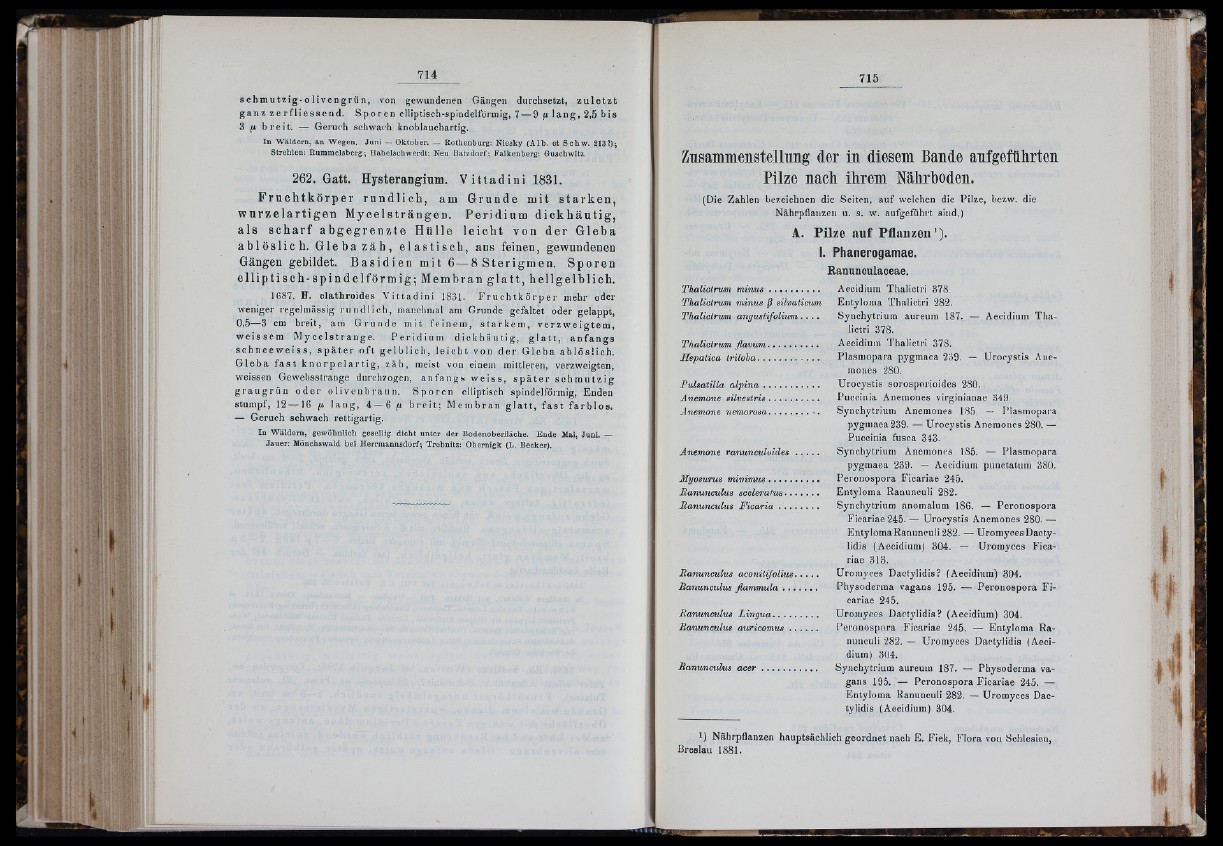
I
i ■
s c h m u t z i g - o l i v e n g r i i n , von gewundenen Gängen durchsetzt, z u l e t z t
g a n z z e r f l i e s s e n d . S p o r e n elliptisch-spindelförmig, 7 — 9 y l a n g , 2,5 b is
3 y b r e i t . — Geruch schwach knoblauchartig.
In Wäldern, an Wegen. Juni — Oktober. — Rothenburg; Niesky (Alb . et S c hw . 213?);
Strehlen: Rummelsberg; Habelschwerdt: Neu Batzdorf; Falkenberg: Guschwitz.
262. Gatt. Hysterangium. Vi t t a d i n i 1831.
F r u c h t k ö r p e r r u n d l i c h , am G ru n de mi t s t a r k e n ,
wu r z e l a r t i g e n My ce l s t r än ge n . P e r i d ium d i c k h ä u t i g ,
al s s c h a r f a b g e g r e n z t e Hül l e l e i cht von de r G leb a
a b 1 ösl ic h. Gle ba zä h , e l a s t i s c h , aus feinen, gewundenen
Gängen gebildet. Ba s i d i e n mi t 6—8 S t er igmen. Sp ore n
e l l i p t i s c h - s p i n d e l f örm i g ; Membran gl a t t , hel lgelbl ich.
1687. H. c la th ro id e s ^M tta d in i 1831. F r u c h t k ö r p e r mehr oder
weniger regelmässig r u n d l i c b , manchmal am Grunde gefaltet oder gelappt,
0,5—3 cm b re it, am G r u n d e m i t f e in em , s t a r k e m , v e r z w e i g t e m ,
w e i s s e m M y c e l s t r ä n g e . P e r i d i u m d i c k h ä u t i g , g l a t t , a n f a n g s
s c h n e e w e i s s , s p ä t e r o f t g e l b l i c h , l e i c h t v o n d e r G l e b a a b lö sH c h .
G l e b a f a s t k n o r p e l a r t i g , z ä h , meist von einem mittleren, verzweigten,
weissen Gewebsstrange durchzogen, a n f a n g s w e i s s , s p ä t e r s c h m u t z i g
g r a u g r ü n o d e r o l i v e n b r a i i n . S p o r e n elliptisch spindelförmig, Enden
stumpf, 12— 16 y l a n g , 4 — 6 y b r e i t ; M em b r a n g l a t t , f a s t f a r b l o s .
— Geruch schwach rettigartig.
In Wäldern, gewöhnlich gesellig dicht u n ter der Bodenoberfläche. Ende Mai, Juni. —
Jauer: Mönchswald bei Herrmannsdorf; Trebnitz: Obernigk (L. Becker).
i ü : , -
Zusammeiistelliing der in diesem Bande anfgeführten
Pilze nach ihrem Nährboden.
(Die Zahlen bezeichnen die Seiten, au f welchen die Pilze, bezw. die
Nährpflanzen u. s. w. aufgeführt sind.)
A. P ilz e a u f P fla n z e n ').
I. Phanerogamae.
Ranunculaceae.
Thalictrum m in u s ..................... Aecidium Thalictri 378.
Thalictrum minus ß silvaticum Entyloma Thalictri 282.
Thalictrum angustifolium Synchytrium aureum 187. — Aecidium T h a lictri
378.
Thalictrum fla v um ..................... Aecidium Thalictri 378.
Hepática triloba.......................... Plasmopara pygmaea 239. — Urocystis Anemones
280.
Fulsatilla a lp in a ........................ Urocystis sorosporioides 280.
Anemone silvestris..................... Puccinia Anemones virginianae 349
Anemone nemorosa..................... Synchytrium Anemones 185. — Plasmopara
pygmaea239. — Urocystis Anemones 280. —
Puccinia fusca 343.
Anemone ra n n n cu lo id e s Synchytrium Anemones 185. — Plasmopara
pygmaea 239. — Aecidium punctatum 380.
Myosurus m in im u s ..................... Peronospora Ficariae 245.
Banunculus sceleratus.............. Entyloma Ranunculi 282.
Banunculus F i e a r ia ................. Synchytrium anomaium 186. — Peronospora
Ficariae 245. — Urocystis Anemones 280. —
Entyloma Ranunculi 282. — Üromyces Dactylidis
(Aecidium) 304. — Üromyces Ficariae
313.
Banunculus aconitifolius ü rom y c e s Dactylidis? (Aecidium) 304.
Banunculus flam m u la .............. Physoderma vagans 195. — Peronospora F icariae
245.
Banunculus L in g u a ................... ü rom y c e s Dactylidis? (Aecidium) 304.
Banunculus a u r icom u s i’e ronospora Ficariae 245. — Entyloma Ranunculi
282. — Üromyces Dactylidis {Aecidium)
304.
Banunculus a c e r ........................ Synchytrium aureum 187. — Physoderma vagans
195. — Peronospora Ficariae 245. —
Entyloma Ranunculi 282. — ürom yc e s Dactylidis
(Aecidium) 304.
’ ) NährpflaDzen hauptsächlich geordnet nach E. Fiek, F lo ra von Schlesien,
Breslau 1881.
ift